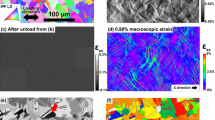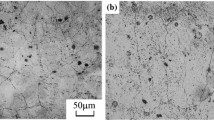Abstract
The effects of crystallographic orientation on the fatigue crack growth behavior of MAR-M200* single crystals were examined. Using compact-tension specimens tested at 20 Hz, fatigue crack growth rates were determined at ambient temperature at minimum stress to maximum stress ratios,R, of 0.1 and 0.5. In most cases, subcritical crack growth occurred either along a single {111} slip plane or a combination of {111} planes. The mode of cracking was generally mixed and contained mode I, II, and III components. Considerable crack deflection and branching were also observed. Some fracture surfaces were found to contain a significant amount of asperities and, in some specimens, black debris. Based on Auger spectroscopic analyses and the fracture surface appearance, it appears that the black debris represented oxides formed due to rubbing of the fracture surfaces. Using stress intensity solutions obtained based on the Boundary-Integral-Equation technique, an effective ΔK was successfully used for correlating the crack growth rate data. The results indicate that the effect of crystallographic orientation on crack growth rate can be explained on the basis of crack deflection, branching, and roughness-induced crack closure.
Similar content being viewed by others
References
M. D. Gell, D. N. Duhl, and A. F. Giamei: in Superalloys 1980,Proceedings of the Fourth Int. Sym. on Superalloys, ASM International, Metals Park, OH, 1980, pp. 205–14.
G. R. Leverant and B. H. Kear:Metall. Trans., 1970, vol. 1, pp. 491–98.
D. P. DeLuca and B. A. Cowles: AFWAL-TR-84-4167, 1984.
M. Gell and G. R. Leverant:Trans. AIME, 1968, vol. 242, pp. 1869–79.
G. R. Leverant and M. Gell:Trans. AIME, 1969, vol. 245, pp. 1167–73.
G. R. Leverant and M. Gell:Metall. Trans. A, 1975, vol. 6A, pp. 367–71.
D. L. Anton:Acta Metall., 1984, vol. 32, pp. 1669–79.
P. J. E. Forsyth:Proc. of the Crack Propagation Symposium, Cranfield, 1961, vol. I, pp. 76–94.
G. R. Leverant, T. E. Strangman, and B. S. Langer:Superalloys: Metallurgy and Manufacture, Claitor’s Publishing Division, Baton Rouge, LA, 1976, pp. 285–95.
J.S. Crompton and J. W. Martin:Metall. Trans. A, 1984, vol. 15A, pp. 1711–19.
M. A. Hicks and C. W. Brown:Fatigue 84, C. J. Beevers, ed., Engineering Materials Advisory Services, Ltd., Cradley Heath, U.K., 1984, vol. 3, pp. 1337–47.
ASTM E-647: Annual Book of ASTM Standard, ASTM, Philadelphia, PA, 1983, pp. 710-30.
M. D. Snyder and T. A. Cruse:Int. J. Fracture, 1975, vol. 11, pp. 315–28.
T. A. Cruse:Applied Mathematical Modeling, 1978, vol. 2, pp. 287–93.
K. S. Chan and T. A. Cruse:Engineering Fracture Mechanics, 1986, vol. 23, pp. 863–74.
K. S. Chan, J. E. Hack, and G. R. Leverant:Metall. Trans. A, 1986, vol. 17A, pp. 1739–50.
M. D. Peach and J. S. Koehler:Phys. Rev., 1950, vol. 80, pp. 436–39.
G. P. Cherepanov:Mechanics of Brittle Fracture, McGraw-Hill, New York, NY, 1979, pp. 71–78.
P. C. Paris and G. C. Sih: inFracture Toughness Testing and Its Application, ASTM STP 381, ASTM, Philadelphia, PA, 1965, pp. 30–83.
G. C. Sih and H. Liebowitz: inFracture, H. Liebowitz, ed., Academic Press, New York, NY, 1968, vol. 2, pp. 67–190.
D. A. Koss and K. S. Chan:Acta Metall., 1980, vol. 28, pp. 1245–52.
D. A. Koss and K. S. Chan: inDislocation Modeling of Physical Systems, Pergamon Press, Oxford, U.K., 1981, pp. 18–22.
K. S. Chan:Acta Metall., 1986, in press.
S. Suresh:Metall Trans. A, 1985, vol. 16A, pp. 249–60.
S. Suresh and R. O. Ritchie:Metall. Trans. A, 1982, vol. 13A, pp. 1627–31.
Author information
Authors and Affiliations
Additional information
Formerly with Southwest Research Institute
Rights and permissions
About this article
Cite this article
Chan, K.S., Hack, J.E. & Leverant, G.R. Fatigue crack growth in MAR-M200 single crystals. Metall Trans A 18, 581–591 (1987). https://doi.org/10.1007/BF02649474
Received:
Published:
Issue Date:
DOI: https://doi.org/10.1007/BF02649474




